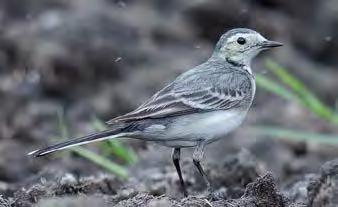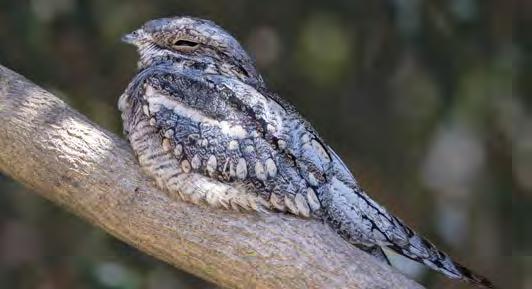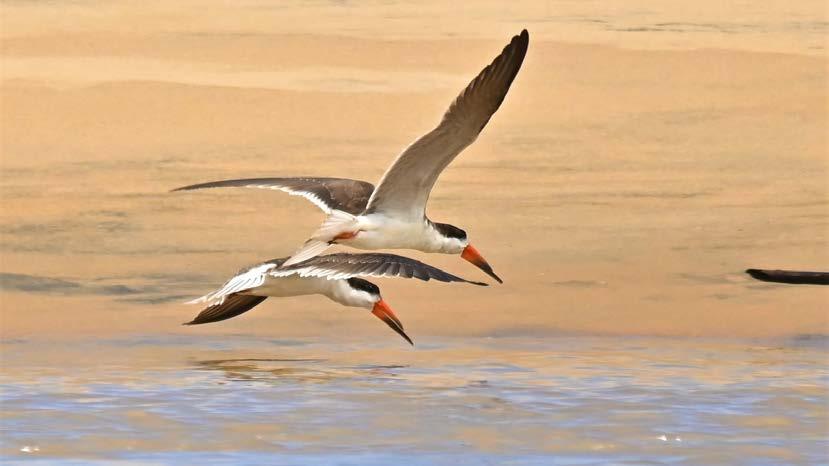
7 minute read
A Summer to Remember for KZN
First a little bit about beautiful KwaZulu-Natal (KZN) as we have readers from all over the world reading this magazine.
KwaZulu-Natal is the best!
Advertisement
KwaZulu-Natal is a province on South Africa’s east coast. With the Indian Ocean forming its shoreline it is graced with a warm, subtropical climate with high levels of humidity throughout the year. Only two distinct seasons make up the beautiful mild climate with a dry, cooler season from May to August and a hot, wet season from November to March. During the wet season, thunderstorms are common and accompanied by heavy rainfall.
Diversity of habitat
KZN has a varied topography, ranging from coastal plains to mountainous regions forming one of the steepest gradient coastlines in the world. It moves from the eastern coastal areas bordered by the warm Indian Ocean in the east and the Drakensberg mountains in the West.

The coastal plains are characterised by sandy beaches, dunes and wetlands. The inland areas of the province have grasslands and mountains, with the Drakensberg Mountains forming the western border of the province.
The vegetation is diverse and includes subtropical coastal forests and mistbelt higher altitude forests, savannas, grasslands, and wetlands. The province is also home to a number of unique and endemic plant species.
The coastal region is characterised by dense coastal forests, estuaries with mangroves, wetlands and salt-marsh, while the inland areas are dominated by savannas and grasslands.




KwaZulu-Natal a birdwatchers paradise
KZN is a birdwatcher’s paradise, with over 600 bird species recorded in the province (South Africa has a total of just over 850). This is attributable to the diverse range of habitats, climate and topography. Some of the iconic bird species found in KZN include the Southern Ground Hornbill, Blue Crane, and African Fish Eagle. The province is also home to a number of localised bird species, including Pink-throated Twinspot, Woodward’s Batis and Rudd’s Apalis to name a few.
The Summer of 22/23
The summer of 22/23, stretching from November to March, has brought a wide range of vagrants, migrants and bird species some of which have never been recorded in South Africa before.
November 2022 saw a flurry of bird sightings across the province, as the migrants started arriving in full force offering exciting opportunities for bird enthusiasts to start their summer birding exploring the region’s diverse habitats.
Highlights in early November 2022 were the sightings of two Green Sandpiper, one in Underberg, near Castleburn Resort, and another on the uMfolozi estuary.
A Rufous-bellied Heron (see photo overleaf) returned to the uMbogavango Nature Reserve in Amanzimtoti, while a male Pennantwinged Nightjar was reported to have been seen at Southbroom Bowling Club. However, subsequent searches did not manage to relocate this bird again.
The sighting reports started coming in fast as the summer kicked in with Broad-billed Roller seen just south of Mtunzini, and a Sooty Falcon reported flying up Riverhorse Valley, in the northern Durban suburbs.
At Mpempe Pan as many as six Caspian Plovers remained and a Rufous-bellied Heron was still present at Amazibu hide in the Eastern Shores Section of iSimangaliso Wetland Park.
Later in November, a Woodland Kingfisher was spotted in a garden in Wartburg and remained there for several days while an African Crake was reported on a farm in New Hanover.
The end of November, however delivered a megatwitch to KZN when a rare sighting of White Wagtail was reported from a sludge deposit alongside the Sappi Stanger factory in Stanger. This sighting drew them in and many local twitchers as well as a few from further afield flocked to see this rare visitor. Roger Hogg sent in his personal account of this sightings - see his experience described at the end of this article. A Western Yellow Wagtail was also found in the same area, adding to incentive to visit the site.
The excitment continued through December and we were only into the second month of summer. This saw the reports starting with the second sighting of White Wagtail in Stanger’s Sappi wetlands. The bird was spotted on Tuesday and entertained many twitchers before it disappeared overnight and was not seen again. At the same location, twitchers also spotted at least one Lesser Jacana.
A female Golden Pipit turned up again for the summer at Manyoni Private Game Reserve, Zululand and a Sooty Falcon was reported from the Eucalyptus trees in Mbazwana in northern KZN and another individual near Mtunzini.


Excitement levels ramped up with the reports of an immature Crab Plover discovered on the banks of the lower uMlalazi Estuary, Mtunzini, where it drew the attention of many birdwatchers.

Also noteworthy were two sightings of three Yellow-billed Oxpecker on the Munyawana Conservancy before and after Christmas.
As December and the year started drawing to a close, the Crab Plover was still present at the uMlalazi Estuary, with the addition of a Eurasian Oystercatcher. The four Caspian Plover remained at Mpempe Pan and further west two Lesser Moorhen were reported from Nambiti Private Game Reserve.
The last few days of December showed that 2022 wasn’t yet finished with the twitchers. An excellent sighting and record of a Thick-billed Cuckoo seen on the Sand Forest walk at Ndumo Game Reserve on the 29 December 2022 had people hopping, while a juvenile Capped Wheatear was seen just off the boardwalk at the Lake St Lucia Estuary mouth - the first of what would be some extraordinary sightings in the iSimangaliso Park.
Northern Zululand, specifically Muzi and Mpempe Pans, continued to deliver specials with Caspian Plover, Allen’s Gallinule, Western Marsh Harrier, and an Ayres’s Hawk Eagle reported from these areas.

The next three months from January to March 2023 provided a smorgasbord of new ticks for many birders with one of these records being a highly significant and emotional one for the author.
The reports and specials came through from all over KZN at quite a pace. The species over this time included Dwarf Bittern at Waterford Farm in Gingindlovu, as well as in uMkhuze Game Reserve and while the upland birders were treated to regular Red-footed Falcon along the Bushmansnek road near Underberg.


A Bronze-winged Courser in rural Uvongo and one in Nambiti Private Game Reserve added this species to their list. Pearl-breasted Swallow at Saxony Wildlife and an immature Lesser Grey Shrike at Lake Eland started providing excitement in other areas of KZN beyond the Zululand specials that we kicked off with.
A slew of waterbirds west of Pietermaritzburg with Lark-like Bunting on Sani Pass, Black Heron south of Mooi River, Blacknecked Grebe at Luthuli Sanctuary Dam in Nambiti Private Game Reserve (Ladysmith area) and a Lesser Moorhen on a farm dam in Nottingham Road. It wasnt long before Zululand started competing again with records of two Blacknecked Grebe at Sutton Dam on the Munyawana Conservancy providing a rare record - only six previous records for KZN - a Hooded Vulture at Sungulwana Game Lodge and a Bulwer’s Petrel in poor condition found alongside the Ngoboseleni Estuary at Sodwana Bay in the iSimangaliso Wetland Park. The bird was picked up and taken into care at a rehab center in Durban.
Not a dull moment so far and March had more to give. Lesser Moorhen continued to be picked up at a number of locations including Simbithi Ecoestate in Ballito, Nottingham Road, and in the Western Shores section of the iSimangaliso Wetland Park.
A Temmincks courser was reported from Fig Tree Farm in Hillcrest and then even more surprisingly turned up at the old airport site in iSiphingo. But there is one of the rarities and specials not yet discussed ...
Keeping the best for last, the one sighting not mentioned, came four days into January 2023 and stayed.
The incredible news of the sighting of three African Skimmer at the mouth of the Lake St Lucia estuary produced a very visceral reaction in the lead author. This species has been considered to be extinct as a breeding bird in South Africa and was last recorded breeding in the mouth area of the Lake St Lucia estuary in 1943.

Although there have been scattered records of mostly singletons over the years, particularly from northern South Africa, this species is still considered a national rarity in the country.
The significance of this record and the delight which their prolonged stay has continued to evoke requires further explanation. I was for almost a decade from 2010 contracted by the iSimangaliso Authority to manage the component of the GEF-funded iSimangaliso World Heritage Site programme that dealt with the restoration of the Lake St Lucia estuary. Part of the project involved supervisory missions from the administratorys of the fund, the World Bank and one of the people involved was their ecologist Dr George Ledec. George like me is a demented twitcher who has a world bird list in excess of 6 500 (all seen).
Restoration of the Lake St Lucia estuary often had George and I discussing how we would recognise when the restoration goals had been achieved. During these discussions George kept pushing for an indicator, a difficult in an estuarine context because these systems and particularly Lake St Lucia naturally fluctuate through a variety of statesfrom fresh, to brackish to hypersaline depending on rainfall and river flows.
Eventually, given George’s bird obsession and knowing that African Skimmer had bred at Lake St Lucia before the intense manipulation of the estuary began, I volunteered tongue-in-cheek that “when the African Skimmers come back we will have got there”.
This became the oft-repeated aspirational ending of my many presentations (165 in all), on the restoration of the Lake St Lucia estuary. It was there as a hope and and dream ending which people who have heard my presentation might remember.
The presence of these three skimmers in the Lake St Lucia Estuary area over the last few months generated a YES! At last! heartful response to an incredibly challenging, rewarding but stressful period. And the three birds are still there voting with their wings and beaks...
These sightings are just a teaser of the variety of bird species that can be observed in KZN. From the rarities seen this past summer, Green Sandpiper to the White Wagtail, and with the huge complement of resident species KZN is a birdwatcher’s paradise. Whether you are an avid birdwatcher or a casual observer, KZN’s diverse habitats offer something for everyone. So pack your binoculars and head out to explore the natural beauty of KZN, you never know what feathered friends you might find.
Text | Nicolette Forbes













